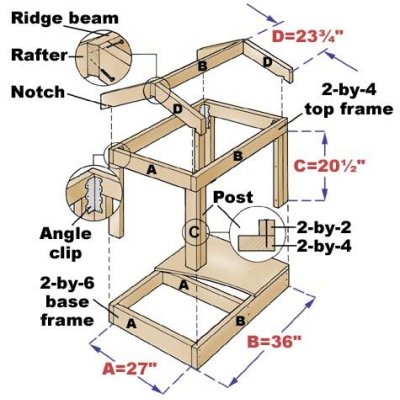🌵 azWoodman.com 🌵
Arizona Specialty Woodcrafts
🐶 Building a Dog House~ by Kevin Ireland After our faithful golden retriever Chance died at the grand old age of 15, I knew I'd need to do two things. First, head back to his breeder. Anybody who could produce a sweet-tempered dog that lived that long deserved repeat business. Second, build a doghouse to replace the one I'd made for Chance when he was a puppy. The old house had held up well, but it was beginning to show its age. Besides, every new dog deserves new digs. After our faithful golden retriever Chance died at the grand old age of 15, I knew I'd need to do two things. First, head back to his breeder. Anybody who could produce a sweet-tempered dog that lived that long deserved repeat business. Second, build a doghouse to replace the one I'd made for Chance when he was a puppy. The old house had held up well, but it was beginning to show its age. Besides, every new dog deserves new digs.
 Kevins design for his new pal, Chase ... shown here ↪ Kevins design for his new pal, Chase ... shown here ↪
This design incorporates a porch and extended "saltbox" roof attached to the basic doghouse design. The basic house is simple to build, and if you want to add extras, as Kevin did, you'll see that the underlying structure is easy to adapt. Size the house to fit the dog: It's tempting to make a really roomy doghouse, but your dog won't appreciate it. During cold months, your dog's body heat keeps him or her warm. If the house is too big, the dog can't generate enough heat to warm it. How big should a doghouse be? There's no exact formula, but a good rule of thumb is to build it so your full-grown dog can walk in, turn around inside and stretch out completely. Vent it well: In hot weather, good airflow will keep your dog from overheating. And in damp weather or cold weather, when the dog's moist breath is steaming up the house, proper ventilation prevents mold from forming. Vents in the peaks of the roof will do the job as long as you leave the doorway open or just loosely cover it with a flap so there's an adequate updraft. Build it off the ground: This keeps the dog out of contact with damp soil. It also prevents the wood from rotting and extends the life of the doghouse. Make it safe from the elements: Be sure water, wind and rain can't enter. Generally, this means overhangs for doorways and vents, and tight seams everywhere. |
🐶 Using Pressure-treated Wood:Pressure-treated wood is great at standing up to moisture and rot because it's impregnated with arsenic and heavy metals. However, these are poisonous to pets and people. For this reason, don't use it for the floor, walls or any other parts of a doghouse that will come into contact with your pet.That said, I used pressure-treated wood for the base frame of Chase's saltbox because his house will sit on the earth. The siding overlap minimizes the amount of pressure-treated wood that's exposed, but I'm keeping an eye on him to make sure he doesn't chew it. If he does, I'll cover the exposed frame with plywood scraps left over from making the house. By the way, I was careful to wear work gloves and a dust mask when I was working with the pressure-treated wood. You should, too. Use dog-friendly materials: Anything that comes into contact with your pet must be safe for animals. That means you'll make the floor, frame and walls from untreated softwood and plywood, rather than pressure-treated wood. Customize to suit: Once the basics were covered, I looked at ways to improve on my previous design. First, I added a sheltered porch so our new dog could stay out of the sun and rain. I moved the doorway from the gable end to the porch side, for easy access. (I made the door pup-size for now. It can be enlarged later.) I also added insulation under the floor (to keep out cold in winter) and under the roof (to reduce heat in summer and retain it in winter). Finally, and this was a big improvement, I added a large clean-out door at the back of the house so I could easily tidy up inside. The result is the house shown at the beginning of this article, which has the flavor of a New England saltbox home. It's based on the following basic design. |
🐶 Basic Digs for Your Dog: My house took about 12 hours to build, and the materials cost about $100. But you don't need to go to these lengths to build a comfortable house for your pet. You can build a basic version in an afternoon from plywood, dimension lumber and shingles. My house took about 12 hours to build, and the materials cost about $100. But you don't need to go to these lengths to build a comfortable house for your pet. You can build a basic version in an afternoon from plywood, dimension lumber and shingles.
It's a simple, sound design that handles a dog of 70 lbs or so. All framing is cut to just four lengths, shown as dimensions A, B, C and D in the diagram on the next page. To change the overall size of the house, just change the four framing dimensions. For my saltbox design, I simply extended the rafters and base frame on one side to create the covered porch shown in the photo that kicks off this story. |
| TOOLS: | MATERIALS: |
|---|---|
| ▸ Tape measure | ▸ Dimension lumber: see chart |
| ▸ Speed square | ▸ (2) 4' x 8' sheets, 3/4" exterior plywood |
| ▸ Carpenter's pencil | ▸ (8) 7" angle clips |
| ▸ Circular saw | ▸ (1) 4' x 4' or 4' x 8' sheet, 2", hard foam insulation |
| ▸ Chop saw | ▸ Construction adhesive |
| ▸ Jigsaw | ▸ Drip edge, 14ft |
| ▸ Hacksaw | ▸ Tar paper |
| ▸ Handsaw | ▸ Exterior caulk |
| ▸ Framing hammer | ▸ (1) bundle roofing shingles |
| ▸ Staple gun | ▸ 4d galvanized nails |
| ▸ Socket wrench | ▸ 12d galvanized nails |
| ▸ Adjustable wrench | ▸ 3" outdoor screws |
| ▸ 1½" outdoor screws | |
| ▸ Aluminum roofing nails | |
| ▸ Pre-fabricated shelves |
💡 Tips From the Pros:First, cut all the 2-by lumber before you start construction. Cut the first piece of a given size, and then use that piece to mark the dimensions of its mates. A carpenter's pencil or lumber crayon is handy for marking the cut pieces.Second, you want the walls to fit the actual frame, so don't cut the plywood until you've assembled the framing and measured it. This compensates for the inevitable minor assembly errors, and your finished house will be all the better for it. |

⦿ Dimension Lumber for a Basic Doghouse |
|||
| Nominal Size & Length | Quantity | Lengths to Cut | How Many Needed |
|---|---|---|---|
| 2'' x 6'', 8 ft | 2 | A, B | 2, 2 |
| 2'' x 2'', 8 ft | 1 | C | 4 |
| 2'' x 4'', 8 ft | 4 | C, A, B, D | 4, 2, 2, 4 |
| 2'' x 4'', 4 ft | 1 | B | 1 |
| 1'' x 2'', 8 ft | 4 | C, D | Threshold:8, 4 |
🐶 About by Kevin Ireland
Kevin Ireland was formerly managing editor at both American Woodworker magazine, Rodale Woodworking and Do-It-Yourself Books. Kevin was raised in a fixer-upper and has rebuilt three homes in the last several years.
🐕 Dog Houses with Porches:
No time to Build Your Own? How about a Ready-made Dog House ...📌 We are a participant in the Amazon.com Services LLC Associates Program, an affiliate advertising program designed to provide a means for sites to earn advertising fees by advertising and linking to Amazon.com.

 Lay out the wall panels on the plywood, taking actual dimensions from the frame itself. Cut and install the sides first, then measure, cut, and install the front and back (the gable ends). Note that the ends overlap the sides. All four pieces need to overhang the base by 1½". Fasten the siding to the wall framing and base with 4d galvanized nails or 1½" outdoor screws.
Lay out the wall panels on the plywood, taking actual dimensions from the frame itself. Cut and install the sides first, then measure, cut, and install the front and back (the gable ends). Note that the ends overlap the sides. All four pieces need to overhang the base by 1½". Fasten the siding to the wall framing and base with 4d galvanized nails or 1½" outdoor screws.




